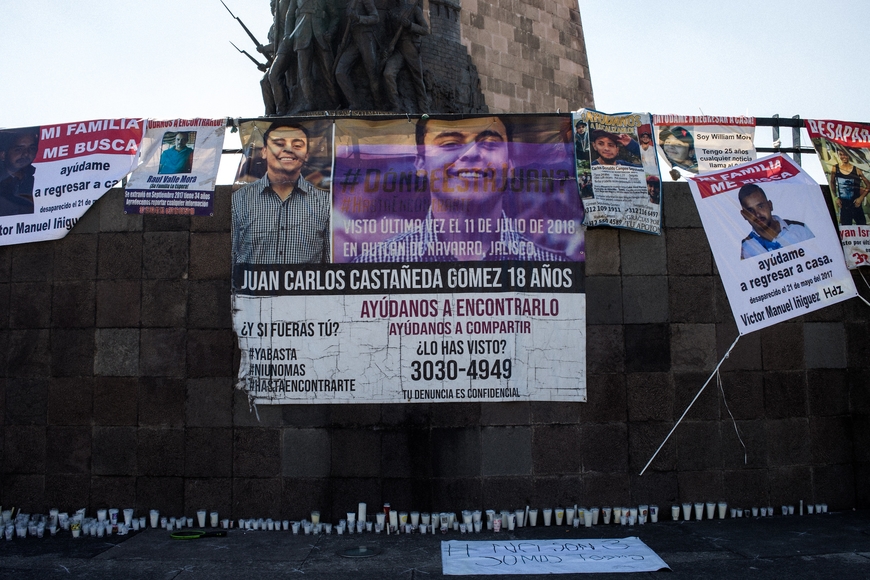Building a Human Rights Database: A View from the Ground
There are over 70,000 reported disappearances in Mexico since 2006. Most of these cases remain unsolved and very few have led to a conviction, failed by a criminal justice system, and often characterized by silence, impunity and corruption.
Despite the many obstacles they face in their pursuit of truth and justice, families of the disappeared, NGOs and researchers alike continue their mission to unmask the fate of the disappeared and the nature of the systems that have croncially failed them.
One such organization has taken root here at the University of Minnesota. The research team operates as a branch of the Observatory on Disappearances and Impunity in Mexico, led by Human Rights Program Director Barbara Frey.
The Observatory
The Observatory is an international academic collaborative seeking to establish a body of research that investigates, analyzes, and combats patterns of impunity regarding enforced disappearances in Mexico. It is led by three principal investigators: Professor Leigh Payne of Oxford University, Professor Karina Ansolabehere of the Institute for Research (IIJ-UNAM) and the Latin American Faculty of Social Sciences (FLACSO-Mexico), as well as Frey of the University of Minnesota.
The University of Minnesota’s branch is composed of dozens of Spanish-speaking undergraduate and graduate students who analyze Mexican media sources that report on disappearances. This work consists of reading local news articles about disappearances, and codifying all the information those articles provide about the cases they are reporting. (For example, does the article mention the victim’s full name, gender, where they were last seen, who were the perpetrators, was an investigation opened, what was the final outcome of the case, etc.) Since it began the work in 2015, the Minnesota team has coded over 5,000 press articles on 664 cases of disappearances in four Mexican states: Coahuila, Guerrero, Jalisco and Nuevo Leon.
Some preliminary findings from our press database
So what can we learn from these public press accounts about disappearance cases in Mexico?
Some of our early findings show that the locations in these four states with the highest levels of disappearances included Piedras Negras, Coahuila (10%); Monterrey, Nuevo León (8%); Lagos de Moreno, Jalisco (7%); Torreon, Coahuila (6%); and Chilapa de Alvarez, Guerrero (5%).
The press accounts show that a majority, 56%, of victims disappeared alone while 44% disappeared in a group.
The press reports confirm the youth of the victims: 1 out of 5 (20%) reported victims were 10 to 17 years old, and a third of the victims (33%) were between 18 and 25.
Occupation was reported in half (51%) of reported cases. Out of cases where occupation was reported, nearly a third (30%) of victims were service workers, 16% were professionals, and 13% were students.
The thousands of hours spent combing through articles has resulted in a large central database -- soon to be released publicly, that helps us identify patterns that explain the nature of disappearances in these four states.
In nearly 3 out of 5 (59%) cases, the press did not report a suspected perpetrator. Of cases where a perpetrator was reported, nearly a fourth (23%) were state actors while slightly over a half (55%) were non-state actors. The remaining fourth (21%) of the reported disappearances were perpetrated by both state and private actors acting together.
The summer team
Over the course of the summer a small team of researchers set out to complete the database, which included finishing the coding of the data, translating the coding manual for the website, and running analytics on the information to identify patterns among the thousands of press reports. These findings will be published via the Human Rights Program’s website on a new webpage called The Observatory Press Database, expected this fall.
This summer’s University of Minnesota cohort included Maria Ignacia Terra, an alumni of the Master of Human Rights program now living in Chile; Yolanda Burckhardt, a second year Human Rights Master’s student; Victor Florence, a prospective Human Rights Master’s student in Florida; and two undergraduate interns, Maria Larson and Rosaleen Joyce.
Crafting the Narrative
One of the central goals in the publication of this work is to raise visibility around the ongoing crime of enforced disappearances to an English language audience, especially policy makers in the United States, who have an outsized influence on the policies and practices of the Mexican Government.
The Minnesota team is primarily concerned with contextualization of the crisis, so that non-Mexican audiences understand how and why these disappearances take place. To accomplish this, team members Larson and Joyce focused on background summaries of four key states. These summaries, in addition to providing general information on the governments and demographics of each state, will familiarize readers with the myths that surround enforced disappearances in Mexico, the (in)effectiveness of government policies in combating this phenomenon and the role of law enforcement both on a local and national scale.
Using these narratives, the team worked together to envision the best web design for the Observatory Press Database. This process presented the team with the opportunity to think of their narrative in a new way, and to highlight the key findings of the press database. Volunteer Victor Florence described the relevance of crafting a broader story about the research as valuable because the data make it possible “to actually see the narrative happening right there.” Additionally, Florence sees the straightforward style of the website and employment of photos and charts as being “vital… for access to a general audience”. The web page will be available to a bilingual audience, with central components featured in both English and Spanish.
Coding Challenges
Members of this summer’s team can confirm that data cleaning and revision, oftentimes tedious tasks, are vital to the data analysis process. “Data analysis relies on harmonization,” says Frey. “Harmonizing the work of all the various coders is needed to minimize the different interpretations of coders… it means taking a second look at answers by coders that did not look like they made sense.”
The most common issues among coders were assumptions not uniformly made by the coders. For example, Terra described that coders sometimes had difficulty keeping themselves from including coding based on assumptions -- about locations, nationalities, perpetrators or outcomes in the cases -- instead of representing exactly what was reported in the press article. She emphasized that the database serves to reflect what is published about the disappearance, and also to show what is not being published in the media’s framing.
Once the data was cleaned, Burckhardt’s job was to analyze it. The three central questions guiding her analysis were: What can we learn from this dataset? How can it be useful to other people? And what can we put on the website that people can use for their own research? She additionally paid particular attention to what the press did or did not report about the victims, if any perpetrators were mentioned, the details of the disappearance, and what was the final reported outcome in the case, if any. A main challenge with analyzing the data was determining what patterns were relevant to understanding the crimes. Comparisons with other government or NGO data on disappearances may not be helpful because of the different methodologies used to gather the data. Instead, the team sought to understand what kind of narrative the press reports were presenting -- who was the victim, who were the perpetrators and where did the crime take place. Burckhardt is focusing on presenting the data in an observational format with the hopes of enabling researchers to use this information to spark their own investigations.
Next steps
The Minnesota team will soon be releasing its findings from the press database. In addition to this report, the public will be able to download the press database, along with the coding manual, both of which will be on The Observatory Press Database, a webpage hosted on the Human Rights Program website. The public database will contain only anonymized references to victims and journalists. While links to the coded articles may still exist, allowing readers to find these names, the Observatory will not release these names in its own work product.
The aim of the release of this information is to provide other researchers, human rights advocates and members of the press with tools that can be used to push for greater transparency in judicial proceedings that look to identify and hold accountable those who are found guilty of enforced disappearances in Mexico.
While the Minnesota Observatory team is publicly releasing this information, their efforts are far from over. Frey explains that the next step for the Observatory is to pass on the best practices identified through this effort to additional researchers, in México and other research sites. Frey describes the forthcoming phase as “working with our colleagues in Mexico to train others on how to use available public information to document disappearances. We are likely going to use the articles we already have to work with with our Mexican colleagues”. She underscores the relevance of these practices by saying: “with a crime [such as enforced disappearance] where the evidence itself disappears with the victim, there are incentives for both the perpetrators and the state to avoid information of the crime.” Databases like this access public information that can advance knowledge about the nature of the crime.”
Stay tuned for the release of the University of Minnesota Observatory web page and Observatory Press Database in fall 2020.



